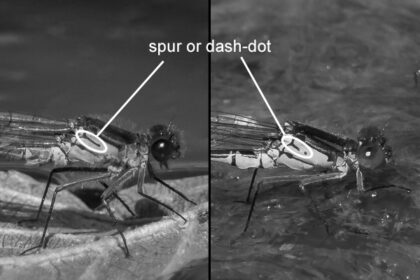We have 5 suspects left in play at this point and we can go straight to 3 of them. The remaining 2 require a little more work.
First, there are gender and colour form neutral ways of identifying a Large Red Damselfly (Pyrrhosoma nuymphula). The side of the thorax and eyes are key.
Next, and you can call me fanciful, but the pattern on the side of the thorax of the Small Red Damselfly (Ceriagrion tenellum) reminds me of a dolphin’s head in profile. This pattern, too, is gender and colour form (of the females) neutral.
We still have the tricksy females of the Scarce Blue-tailed Damselfly (Ischnura pumilio) in the mix. It’s a bit of an odd species in that the females change colour dramatically AND don’t share distinguishing features with their males.
For those with a colour fetish, the gaudy aurantiaca phase immature female (bright orange) is glaringly obvious but the mature females are a rather dull, nondescript beast. both share a rather plain thorax side.
That leaves our two red-eyed damselflies, the Red-eyed Damselfly (Erythromma najas) and Small Red-eyed Damselfly (Erythromma viridulum) which still need separating. Both sexes of both species have either a longer “spur” or a shorter spur (a dash) and a dot on the side of the thorax.




